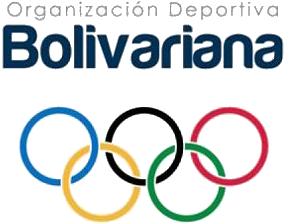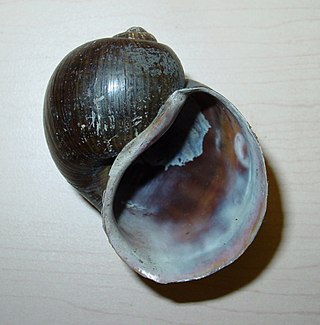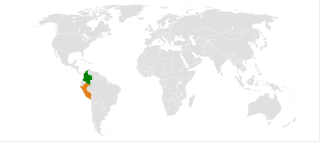
Colombia, officially the Republic of Colombia, is a country mostly in South America with insular regions in North America. The Colombian mainland is bordered by the Caribbean Sea to the north, Venezuela to the east and northeast, Brazil to the southeast, Ecuador and Peru to the south and southwest, the Pacific Ocean to the west, and Panama to the northwest. Colombia is divided into 32 departments. The Capital District of Bogotá is also the country's largest city hosting the main financial and cultural hub. Other major urbes include Medellín, Cali, Barranquilla, Cartagena, Santa Marta, Cúcuta, Ibagué, Villavicencio and Bucaramanga. It covers an area of 1,141,748 square kilometers, and has a population of around 52 million. Its rich cultural heritage—including language, religion, cuisine, and art—reflects its history as a colony, fusing cultural elements brought by mass immigration from Europe and the Middle East, with those brought by the African diaspora, as well as with those of the various Indigenous civilizations that predate colonization. Spanish is the official language, although English and 64 other languages are recognized regionally.

Ecuador, officially the Republic of Ecuador, is a country in northwestern South America, bordered by Colombia on the north, Peru on the east and south, and the Pacific Ocean on the west. Ecuador also includes the Galápagos Islands in the Pacific, about 1,000 kilometers (621 mi) west of the mainland. The country's capital and largest city is Quito.

Ampullariidae, commonly known as Apple Snails, is a family of large freshwater snails that includes the Mystery Snail species. They are aquatic gastropod mollusks with a gill and an operculum. These snails simultaneously have a gill and a lung as functional respiratory structures, which are separated by a division of the mantle cavity. This adaptation allows these animals to be amphibious. Species in this family are considered gonochoristic, meaning that each individual organism is either male or female.

The Bolivarian Games are a regional multi-sport event held in honor of Simón Bolívar, and organized by the Bolivarian Sports Organization. The event is open to athletes from Bolivia, Colombia, Ecuador, Panama, Peru, and Venezuela. In 2010, the ODEBO decided to include Chile as the seventh member of ODEBO. Except Panama, all other participating countries are Andean states.

Euconulidae is a taxonomic family of minute, air-breathing land snails, terrestrial pulmonate gastropod mollusks or micromollusks in the superfamily Trochomorphoidea.

Pila is a genus of large freshwater snails with an operculum, African and Asian apple snails, aquatic gastropod mollusks in the family Ampullariidae, the apple snails.

Pomacea is a genus of freshwater snails with gills and an operculum, aquatic gastropod mollusks in the family Ampullariidae, the apple snails. The genus is native to the Americas; most species in this genus are restricted to South America.

Pomacea canaliculata, commonly known as the golden apple snail or the channeled apple snail, is a species of large freshwater snail with gills and an operculum, an aquatic gastropod mollusc in the family Ampullariidae, the apple snails. South American in origin, this species is considered to be in the top 100 of the "World's Worst Invasive Alien Species". It is also ranked as the 40th worst alien species in Europe and the worst alien species of gastropod in Europe.

Pomacea maculata is a species of large freshwater snail with an operculum, an aquatic gastropod mollusk in the family Ampullariidae, the apple snails.
Pomacea pealiana is a South American species of freshwater snail with gills and an operculum, an aquatic gastropod mollusc in the family Ampullariidae, the apple snails.

Colombian–Peruvian relations are the relations between two South American states, Colombia and Peru. Both nations are members of the Community of Latin American and Caribbean States, Lima Group, Organization of Ibero-American States, Organization of American States, Pacific Alliance and the United Nations.

Pomacea columellaris is a South American species of freshwater snail in the apple snail family, Ampullariidae.
Pomacea auriformis is a species of freshwater snail in the family Ampullariidae, described by Lovell Augustus Reeve in 1856 as Ampullaria auriformis. Its distribution is along the Caribbean coast of Central America. There has been debate over whether this species may be a subspecies of Ampullaria hopetonensis.
Pomacea ocanensis is a species of freshwater snail in the Ampullariidae family native to Colombia. Wilhelm Kobelt originally described the species as a subspecies of Ampullaria auriformis in 1914. A critically endangered species, P. ocanensis faces threats of declining habitat quality due to urbanization, local water management, and pollution. It is the only member of Pomacea considered Endangered or Critically Endangered by the IUCN and one of only two Ampullariids to be Critically Endangered.
Pomacea occulta is a species of freshwater snail in the family Ampullariidae. Previously misidentified as the cryptically similar Pomacea maculata, P. occulta was differentiated by Yang et al. in 2019 using DNA barcoding and molecular systematics.

Pomacea fasciata is a freshwater snail in the Ampullariidae family. It is located in Jamaica, Guadeloupe, and Hispaniola. It lays white eggs.

Crommium angustatum was a species of sea snail in the family Ampullinidae. Now extinct, it is known only from fossils. It was originally mistakenly identified as a freshwater snail in the Ampullariidae family. It has been found in France.











